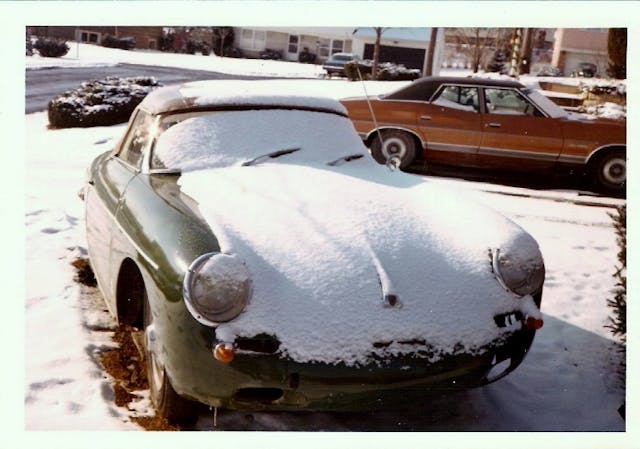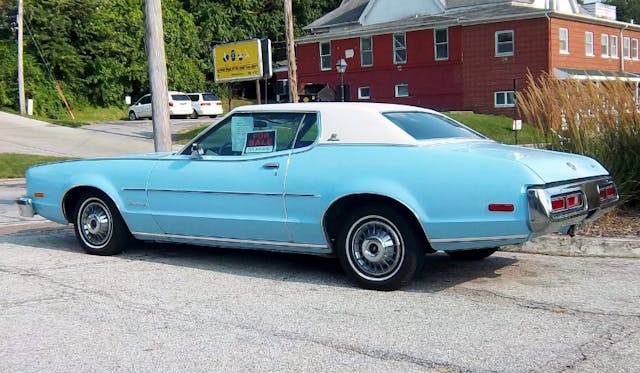Media | Articles
1973 Mercury Montego MX Brougham: Maximum Midsize
Once upon a time in America, consumers could purchase a vehicle that wasn’t only available as a minivan, pickup, or crossover. While there are still some outliers here and there in 2021 motor vehicles, they are rapidly shrinking. It seems like everybody and their dog wants a crossover, and the more tortured the sheetmetal, the better. But I digress. Anyway, nothing could have been further from the truth in 1973, when this baby blue midsizer—full size or beyond by today’s standards—came off the assembly line.
Yes, Mercury. Always the bridesmaid and never the bride. Ford got the fun stuff like the Bronco, the pickups, and the Mustang. Lincoln got the full zoot luxury treatment, with Continentals, Marks, and Cavalry-twill vinyl roofs. Mercury, for most of its life, was caught in between. But it still made some interesting, attractive, and decent-selling cars—cars like the Cougar, Marquis, and Montego.
The Montego first appeared as the top-of-the-line midsized Mercury in 1968. Replacing the Comet nameplate almost entirely (only a single bargain-basement priced Comet remained; the rest were Montegos), it shared a redesigned body with its corporate sibling, the Ford Fairlane, along with its fancier Torino version. Like most domestic cars back then, the Montego was available as a coupe, sedan, station wagon, and convertible.
The basic ’68 body returned for 1969, primarily with new grilles and taillights to differentiate them, but 1970–71 Montegos got new sheetmetal with a prominent pointy nose that proved vulnerable to parking mishaps. For 1972, an all-new Montego appeared.
Marketplace
Buy and sell classics with confidence
As was the custom, it was larger and quieter than its predecessors. Trim levels remained base Montego, Montego MX, and top-of-the-line Montego MX Brougham. A new fastback body style was added, available as a Montego GT, while the two-door hardtop could be had with a sporty Cyclone option package.
For 1973, the model year of today’s featured car, Montegos mostly stayed the same, with the exception of the federally mandated 5-mph front bumper. These so-called park-bench bumpers went on every new 1973 car, but on many Ford Motor Company models they were particularly—ahem—noticeable.
The top model remained the MX Brougham, available as a $3189 sedan, $3209 coupe, or $3606 Villager station wagon (that equates to $17,575, $17,685, and $19,875 today). For comparison’s sake, a base Montego coupe would have had a base price of $2926 ($16,125). The midlevel MX coupe ran $3041 ($16,759). A 250-cubic-inch straight six was standard on coupes and sedans; wagons got the tried and true 302 V-8. The Montegos rode a 114-inch wheelbase, except for wagons, which had a 118-inch span.
MX Brougham were differentiated from lesser Montegos by a flight bench front seat, bright chrome upper body moldings, deluxe wheel covers, and a woodgrain-trimmed steering wheel, along with the expected Brougham emblems. Popular options included air conditioning, dual sport racing side view mirrors, a vinyl roof, luxury wheel covers (as seen on our featured car, they cost an extra $17.64), and SelectShift automatic transmission.
Optional engines, depending on the model, included a 137-horsepower, two-barrel 302 V-8; 161-hp, two-barrel 351 V-8; 248-horse Cobra Jet 351 V-8; 168-hp two-barrel 400 V-8; and a 201-horse 429 V-8. The gas crisis in late 1973 had yet to appear, and gas was still cheap. I don’t think I’ve ever seen a Montego with the 250 six, although I don’t see very many Montegos in the first place.
But I did see this most excellent, nearly showroom-condition coupe back in 2014. I was in Davenport, Iowa, running errands, and it was sitting at a repair shop with a For Sale sign in the window. As usual, I had to stop immediately, park, and check it out.

I have a soft spot for these 1972–76 Montegos and their Gran Torino brethren, because my dad’s first company car was bronze metallic 1973 Gran Torino four-door sedan.
At the time he also had a green 1960 Porsche 356B Roadster. A more different pair of cars would be hard to find!
As for the Montego, it lasted through the 1976 model year with few changes, save a matching biggie 5-mph rear bumper, which was added in ’74. In 1977, both the Gran Torino and Montego got new, more squared-off sheetmetal and were renamed the LTD II and Cougar, respectively. As for that super nice ’73 coupe, I have yet to see it again. All I can do is hope it went to the right home; it was a beaut!




























